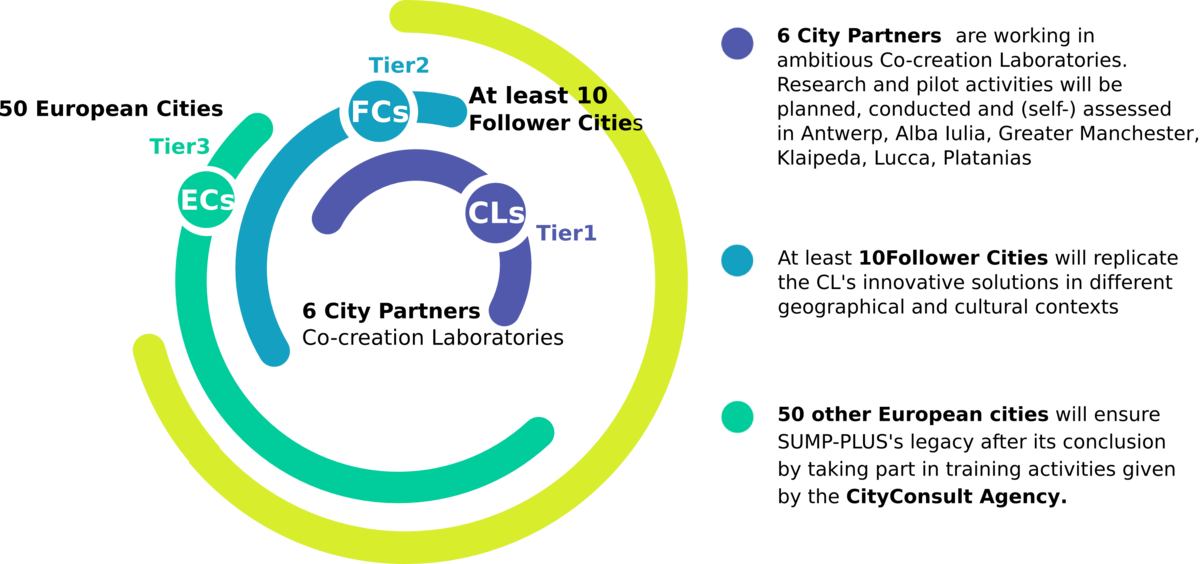The SUMP-PLUS path
SUMP-PLUS is breaking new ground in a variety of ways. It is seeking to develop new processes for mobility pathway development and cross-sector planning; testing innovative products and services for both freight and passenger transport services; and identifying new public-private business and organisational models.
To enable it achieve these goals, which constitute the project’s four primary policy objectives, SUMP-PLUS is using an approach centred on co-created City Laboratories. The concept behind the laboratories is embedded in a multidisciplinary research approach, with the practical experience emerging from this co-created process (which is fine-tuned with the cities), finally being tested and validated in the City Lab activities. This is replicated within a Follower Cities group, with the related expertise passed on to the next generation via knowledge transfer activities organised by the project’s CityConsult Agency.
Broadly speaking, the work of SUMP-PLUS can be divided into three phases:
- Comprehensive research to ensure the City Labs are defined and formed in the right way;
- Application and testing of methods and solutions within the City Labs and replication within Follower Cities, followed by mutual learning and evaluation that refines the concept and its practicality;
- Training related to, and exploitation of, the SUMP-PLUS approach, knowledge and outputs led by the CityConsult Agency.
Building on a theoretical basis
The work within the City Labs builds in part on the conceptual framework developed in CREATE, a CIVITAS project that concluded in June 2018. Of particular importance are efforts to create mobility transition pathways and link mobility to other components within urban systems – these inspired two of SUMP-PLUS’s four main objectives.
Project typology
Due to the varying circumstances and mobility contexts in the European cities, the project determined the need for a city typology that enables differences between the SUMP-PLUS varied city contexts to be compared and identified.
It is recognised that, while each city is unique, most will share some common characteristics with a subset of ‘similar’ cities. The results from individual cities within projects such as SUMP-PLUS are therefore more likely to be transferable to some cities than others - the city typology supports this context-sensitive process.
In time, this means that the typology will benefit not only the six SUMP-PLUS cities, but other cities across Europe seeking to foster sustainable mobility and create efficient and green urban transport systems.
Read the city typology deliverable
In the City Labs
Drawing on the typology, each of the six cities involved is devising its own specific programme of activities. Discover more on their individual pages.
Creating a SUMP implementation pathway towards a liveable city
Integrating decarbonisation strategies across health and transport
MANCHESTER
Using SUMPs to enhance smart city impact and implementation
Co-creating a SUMP for a small island city with seasonal tourism
Providing seamless intermodality and non-transport solutions for a functional urban area
Strengthening sustainable logistics' role in SUMPs in and beyond city centres
LUCCA
Beyond mobility transition pathways and cross-sectoral planning, the demonstration components of the CLs lab will show how cities can make use of new data to better develop mobility policy and how the public and private sector can develop new robust forms of partnerships and business models to meet consumer and citizen requirements.
Sitting behind all of the City Labs are certain ongoing transversal processes, namely stakeholder engagement, governance capacity building, and advanced analytics.
Without the appropriate governance structures, however, it is difficult to unite different levels of government and public, private and civil society organisations behind a common policy approach for fostering sustainable mobility. The project will work to create these in each of its six cities.
The methodology developed for SUMP-PLUS is built on a set of evidence-based methods that forecast whether proposed policies, strategies, plans and designs will work to create the social, economic and environmental benefits that they are expected to. It is also tailored to support cities with limited resources.
Exploiting project knowledge
To ensure that project knowledge is transferred and shared, the project will establish its own “Sharing and Learning Community”. Its three-tier exchange model will allow decision makers and technicians from diverse cities to exchange good practices and facilitate the exploitation of project results.

The city partners will lead this process whilst testing and validating the four SUMP-PLUS components. The rigorous evidence base resulting from practial application, demonstration and evaluation will inform practical guidance tools and a comprehensive training programme. These will serve to pass SUMP-PLUS knowledge on to a wider ciricle of politicians, practitioners and researchers.
The Follower Cities group will be the first to test SUMP-PLUS’s tools and results. This cohort will closely follow their respective CLs and then seek to replicate solutions and approaches applied there. In the process, they will learn about and offer feedback regarding the implementation of city-led research and pilot activities.
The third-tier will comprise around 50 other European cities and will be crucial to ensuring a broad-based legacy for SUMP-PLUS. Under the project’s CityConsult Agency – which will foster city exchanges and transferability – a comprehensive set of training activities and materials will be developed to encourage wide uptake of SUMP-PLUS results. The CityConsult Agency will also be a primary vehicle for continued exploitation following the project’s conclusion.
